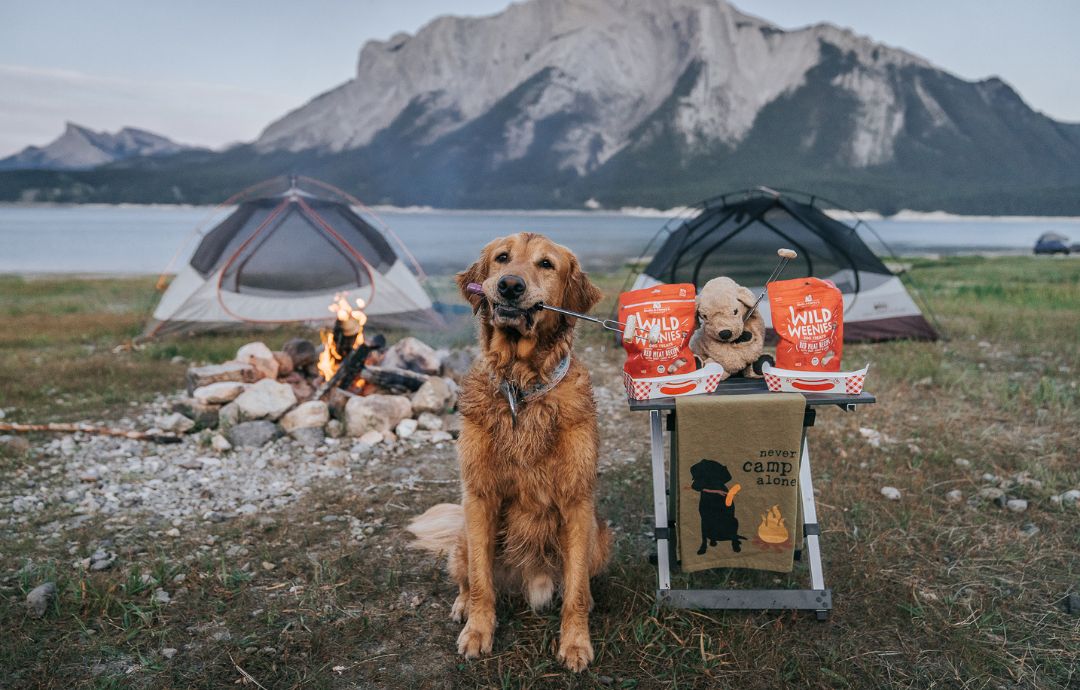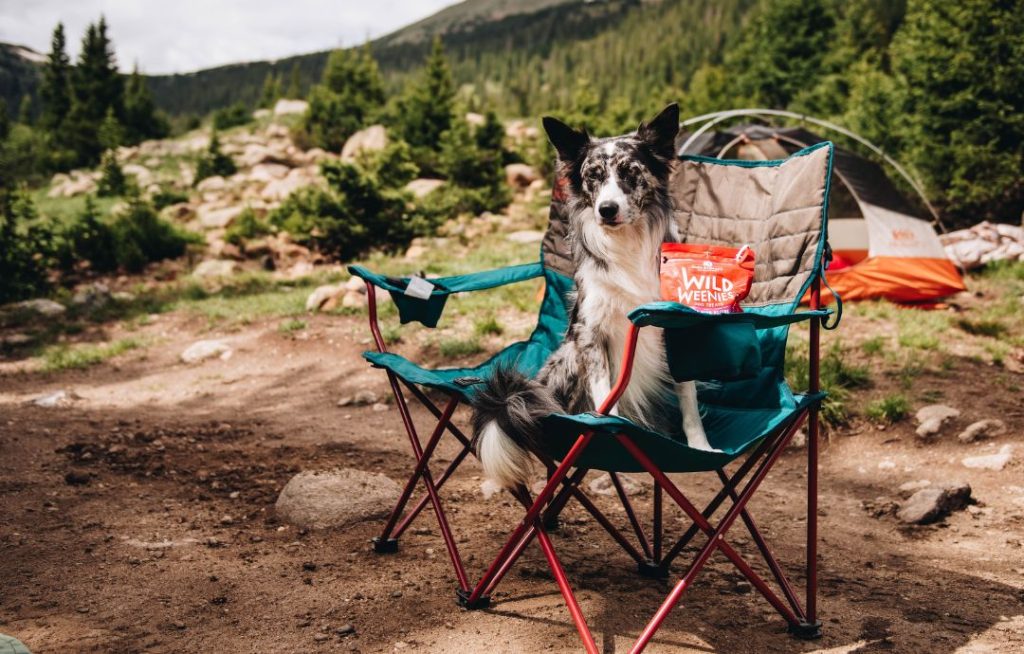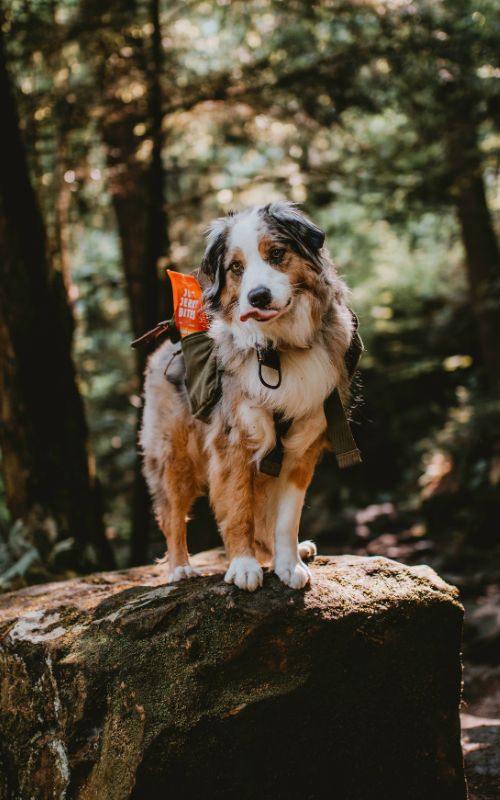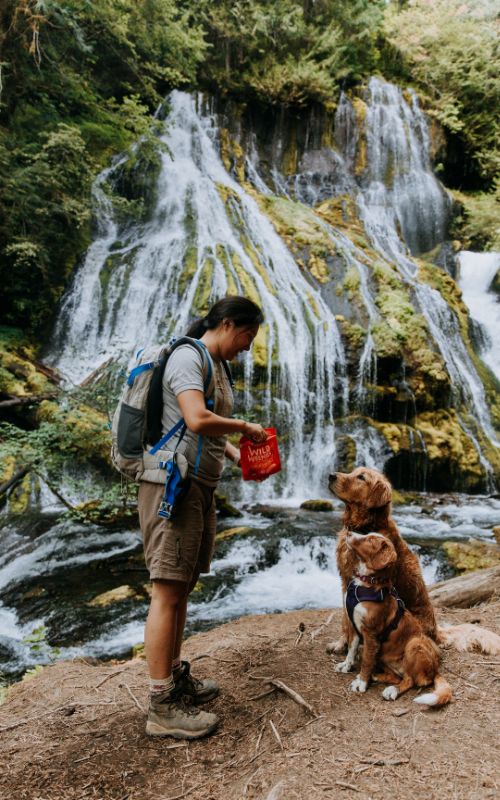
If you love spending time in the great outdoors, you probably want to bring your dog with you on your camping adventures. Camping with dogs can be amazing, but it does take a little extra planning. These tips will help you prepare your pup, and yourself, for a fun and safe trip.
Tips for Camping with Your Dog
Choose a dog-friendly campsite
Not all campgrounds allow dogs, so check for a pet policy before you book a campsite. Many have dog-specific regulations, so you’ll need to check if your dog will be welcome on the trails and/or beaches, for example, in addition to the campsite. If you have multiple dogs, check if there’s a limit on how many dogs are allowed per campsite.
Consider how comfortable your dog is on car rides, and choose a destination accordingly. Plan a route to the campground that makes it easy to stop for relief breaks, and always offer your dog fresh water when you take a break.
Don’t leave your dog alone
Never leave your dog at your campsite alone while you go hiking or into town. To keep your dog safe, you should plan to keep them with you, and on a leash, at all times. Campgrounds are full of temptations for your pup, and most have leash requirements as well.
It’s a good idea to anticipate random dogs wandering up to yours even if they’re lying down and leashed. That scenario (unleashed dog meeting leashed dog) can sometimes be tricky to navigate. Some dogs have added reactivity when they’re leashed and their counterpart isn’t– both dogs tend to get uncomfortable and potentially upset.
Your dog should sleep with you
Whether in a tent, RV, or car, your dog should sleep with you. You’re in the great outdoors and there’s no telling what type of wildlife your dog could encounter at night. Try to keep sleeping arrangements similar to home, if possible. If they sleep in a dog bed or crate, bring it along if you can. If they usually snuggle up with you, make sure your sleeping bag or air mattress can accommodate them.
Tent camping with dogs
- Make sure your tent is big enough to fit your dog’s bed or crate, if they sleep in one
- Trim your dog’s nails before you go camping, or buy a puncture-proof tent liner
- Set the tent up at home first & let your pup get familiar with it before you go camping
RV camping with dogs
- Make sure your dog is comfortable traveling in an RV (if not, let them spend some time in the RV when it’s not moving, then try some short drives to help your dog get used to it)
- When traveling by RV, make sure your dog is secured in their crate or with a dog seat belt – unrestrained dogs can easily be injured in an accident, or distract you while driving
- If leaving your dog alone in the RV, make sure the air conditioning is set to a comfortable temperature. You may want to use a gate to confine your dog to a particular part of the RV while you’re away.
Hammock camping with dogs
- Do a trial run to figure out if your dog will sleep in the hammock with you, or in a separate hammock (trim their nails before they hop in!)
- If your dog is sharing your hammock, hang it extra low to the ground so they can get in and out
- If your dog won’t sleep in a hammock, set up a sleeping area next to or below it (lay down a tarp before the bed or blanket)
- Make sure your rainfly also covers your dog’s sleeping area
- Secure an extra-long leash or tether around your wrist so your dog doesn’t wander off at night
Car camping with dogs
- Figure out how to make a functional sleeping area for you both, before you go camping
- Get screen covers for your car windows so you can leave them cracked for ventilation while sleeping
- Get privacy shades for your car windows to block out light (and heat)
- Never leave your dog in the car alone, even if the windows are cracked
Be sure your dog’s ID tags are up-to-date
It is important that your dog can be easily brought back to you if they get away. In addition to making sure their tags have current information and they are microchipped, consider adding a temporary tag with your campsite number and/or cell phone number. Also be sure to have a current picture of your dog on your cell phone, which probably isn’t a problem for most pet parents!
Pre-camping wellness check
Camping can mean ticks, lots of mosquito bites, and potential injuries. Make sure your pup is up-to-date on their heartworm and tick/flea medications. Be sure to bring a dog first aid kit along with your human supplies, and check with your vet before you leave about mosquito sprays and/or itch relief sprays or ointments that can be used on your pup.
If your dog has thick fur or long hair it’s a good idea to get them groomed before you go camping. That’ll make it easier to remove debris from their coat and check for ticks.
Camping with an anxious dog
The key to enjoying a camping trip with an anxious dog is understanding what triggers their anxiety (loud noises, strangers, separation from their human) and having strategies in place to manage your dog’s anxiety. An anxious dog may be more likely to bark excessively or otherwise act out on a camping trip. To avoid this, train your dog (or work with a professional trainer) on basic obedience skills like recall, and commands that help you refocus their attention away from triggering stimuli. Socializing your dog can also help them feel less fearful around other people and dogs.
When you feel confident that your anxious dog is ready for camping, these tips can help keep them on an even keel:
- Avoid busy or crowded campgrounds – this may mean camping in the off-season, or choosing a less-popular destination
- Reserve a campsite away from high-traffic areas like the entrance, showers, or toilets
- Get lots of exercise with your dog every day
- Bring your dog’s favorite toys and play with them often
- Bring supplements or anti-anxiety meds approved by your vet
- Try a dog anxiety vest to help calm travel stress (make sure they’re comfortable wearing it before your trip)

Checklist: What to pack when camping with your dog
Dog camping essentials include:
- Food & water dishes (collapsible bowls are especially convenient)
- Food & treats
- Fresh water
- Poop bags & scoop
- Dog first aid kit
- Harness & leash (+ extra set of ID tags for harness)
- LED collar light
- Long leash or tether with a stake
- Lots of towels for drying off
- Dog brush & tick key
- Dog sleeping bag, bed, blanket, and/or crate
- Outdoor dog toys
- Allergy or other prescription dog medicine
- Dog mosquito/tick repellent
- Car seat covers (unless your dog travels in a crate)
- Doggy backpack
- Dog life jacket
How to pack dog food for camping
Plan to store your dog’s food in a sturdy, airtight and waterproof storage box or bags. Bring more food than you think you’ll need as your dog will likely be doing more high-energy activities than usual. Packing a dry food, such as Raw Blend Kibble, is a great option for camping, as is Freeze-Dried Raw dog food, which has the additional advantage of being lightweight. And of course your pup will need treats for being a good boy or girl!
Keep the dog food and treats out of the sun, preferably in the trunk of your vehicle. Whatever precautions you are taking to keep bears from getting into your food supply also apply to your dog’s food. Because our dog food is a rich source of quality protein, fat, and nutrients, it’s very attractive to wildlife.
Plan dog-friendly camping activities
You enjoy spending time with your dog, so plan to make it fun for both of you. There are a lot of great dog-friendly camping activities like hiking, going to the beach, canoeing, exploring, and playing!
Unless you’re taking an air-conditioned camper, you should plan on bringing your dog with you everywhere you go for the entire camping trip, so choose your activities accordingly.
Campgrounds, Swimming Areas & Dogs
Some campsites have beaches for humans that dogs aren’t allowed on – this can be a bummer if you are expecting to hang out at the beach with your dog. Other campsites have separate beaches for dogs – which can be equally disappointing if you’re looking for a good place for humans to enjoy the water. Also, leash requirements are often not in play on dog beaches (particularly when the dog is in the water). Make sure you know what types of beaches and leash rules your campsite has so you can plan accordingly!
Winter camping with a dog
Before booking a winter camping trip with your dog, make sure you know what kind of cold weather your dog can handle. If you’ve never taken them on a long walk on a cold day, see how they handle cold temperatures closer to home first.
For winter camping with a dog you’ll need to bring some extra gear like a dog jacket or vest, booties for paw protection, and extra blankets for sleeping. Choose brightly colored accessories and LEDs to make it easier to spot your dog in low light or a snowy landscape. Dry your dog off with towels after a winter hike or playing in the snow.
Learn the early signs of hypothermia and keep a close eye on your dog to make sure they’re not uncomfortably cold. Warning signs include slowed or shallow breathing, shivering, whining, stiff movement, and licking/lifting paws often.
How cold is too cold to camp with a dog? A lot depends on your dog’s size, age, type of coat, and general health. In general, 45°F and higher is considered safe for most dogs. Temperatures below 40-45°F are probably too cold for winter camping with a dog.
Hot weather camping with a dog
Because dogs can overheat more easily than humans, safety is extra important when camping with your dog in hot weather. Keep in mind that depending on your dog’s breed, body size, age, coat, and general health, even temperatures above 75°F might be too hot for them to spend much time outdoors.
Seek shade at your campsite, or make your own shade by hanging a tarp or using a pop-up sun shelter. Use a cooling bandana, cooling body wrap or cooling mat to help your dog stay more comfortable.
If your dog likes the water, plan on visiting dog-friendly swimming areas to cool off, especially during the hottest times of day. Pay extra attention to hydration in hot weather, and keep plenty of cool, fresh water on hand wherever you and your dog go.
Cement, dirt, sand and gravel can get hot enough to burn a dog’s paws, so stick to grassy areas as much as possible and pack protective booties for walks on trails or asphalt.
Know the signs of overheating in dogs, and help them cool down before they develop heat exhaustion. Learn more about walking dogs in hot weather, and limit your dog’s physical activity when they’re at risk of heat stroke.

Will your dog like camping?
Some dogs may not enjoy camping, or may make the experience more stressful for you. You may want to reconsider camping with your dog if any of the following apply:
Your dog barks a lot
If your dog barks at strange noises, or when anxious in new situations, camping may not be for them. Many campgrounds have barking ordinances and may ask you to leave if your dog barks excessively at night.
Your dog is aggressive around other dogs
Dogs from neighboring campsites may approach your dog, so this is an important consideration.
Your dog hates being on a leash
Most campgrounds are strict about keeping dogs on a leash, so if your dog doesn’t like leashes, camping may not be a fun experience for them.
If you’re not sure, plan some activities that let you gauge your dog’s comfort with camping. Go on longer walks and a hike in the woods, and spend more time together outdoors in general. Invite some friends and their dogs over for a cookout or backyard fire, keep your dog leashed, and observe their behavior.
What are the best dogs to camp with?
Any dog that loves outdoor activity, is well-trained, and has the all-clear from the vet is the best dog to camp with! There are also certain outdoor dog breeds that are thought to handle extended time outdoors more easily, including Labrador/Golden Retrievers, Siberian Huskies, Malamutes, Beagles, Rottweilers, Australian Shepherds, Australian Cattle Dogs, Standard Poodles, and any dogs bred for hunting or working.
Of course this doesn’t mean that other dogs can’t enjoy camping! But if you’re an outdoor lover and want to adopt a dog that will love the outdoors along with you, learning more about high-energy, water-loving, and outdoorsy dog breeds is a good place to start.

Is camping safe for dogs?
With the right planning, camping can be both safe and fun for dogs. Follow these safety tips for a camping trip you’ll both enjoy:
- Keep an eye out for wildlife at all times – research birds of prey (especially if you have a small dog), snakes, spiders, bears and other creatures that are common where you’ll be camping
- Keep your dog with you and secure on a leash or tether at all times
- Don’t let your dog drink water from lakes, ponds, rivers, puddles, or anywhere else—only the fresh water you provide
- Know how to identify poison ivy, poison oak, or other poisonous plants in the region, and avoid them
- Your dog will be extra active while camping, so make sure they don’t get dehydrated
- Learn how to check your dog for ticks and bring tweezers or a tick key in the first aid kit
- Bring a dog life vest if you’ll be boating
- Research the nearest emergency vet ahead of time & save the information in your phone (also save your current vet’s number and your dog’s health records in your phone)
Your dog can also help keep you safe while camping: you’ll have an extra pair of eyes, ears and nostrils to alert you to the presence of wild animals. With a little extra preparation, camping with your dog can be an amazing way to spend quality time and bond with your favorite companion out in nature!
GET $3 OFF, INSIDER OFFERS, AND HELPFUL PET CARE TIPS.
By entering your information, you are opting in to receive communication from Stella & Chewy's
